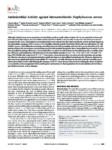Antimicrobial activity against intraosteoblastic Staphylococcus aureus
Although Staphylococcus aureus persistence in osteoblasts, partly as small-colony variants (SCVs), can contribute to bone and
joint infection (BJI) relapses, the intracellular activity of antimicrobials is not currently considered in the choice of treatment
strategies for BJI. Here, antistaphylococcal antimicrobials were evaluated for their intraosteoblastic activity and their impact on
the intracellular emergence of SCVs in an ex vivo osteoblast infection model. Osteoblastic MG63 cells were infected for 2 h with
HG001 S. aureus. After killing the remaining extracellular bacteria with lysostaphin, infected cells were incubated for 24 h with
antimicrobials at the intraosseous concentrations reached with standard therapeutic doses. Intracellular bacteria and SCVs were
then quantified by plating cell lysates. A bactericidal effect was observed with fosfomycin, linezolid, tigecycline, oxacillin, rifampin, ofloxacin, and clindamycin, with reductions in the intracellular inocula of 2.5, 3.1, 3.9, 4.2, 4.9, 4.9, and 5.2
log10 CFU/100,000 cells, respectively (P < 104
). Conversely, a bacteriostatic effect was observed with ceftaroline and teicoplanin, whereas vancomycin and daptomycin had no significant impact on intracellular bacterial growth. Ofloxacin, daptomycin,
and vancomycin significantly limited intracellular SCV emergence. Overall, ofloxacin was the only molecule to combine an excellent intracellular activity while limiting the emergence of SCVs. These data provide a basis for refining the choice of antibiotics to prioritise in the management of BJI, justifying the combination of a fluoroquinolone for its intracellular activity with an
anti-biofilm molecule, such as rifampin.



